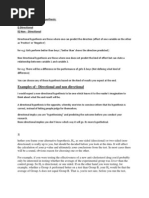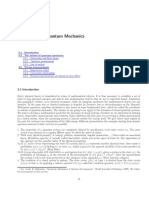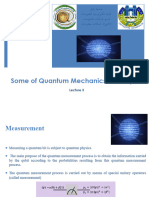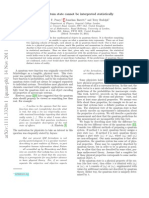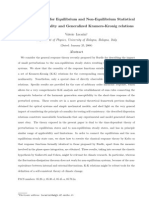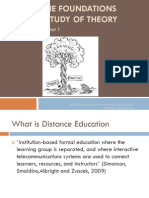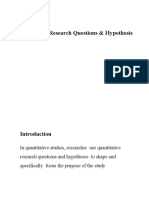Lecture 5
Lecture 5
Uploaded by
Mario CacasennoCopyright:
Available Formats
Lecture 5
Lecture 5
Uploaded by
Mario CacasennoCopyright
Available Formats
Share this document
Did you find this document useful?
Is this content inappropriate?
Copyright:
Available Formats
Lecture 5
Lecture 5
Uploaded by
Mario CacasennoCopyright:
Available Formats
Interpretation of Quantum Theory J. Emerson and R.
Laamme (Instructors) Problems for the Orthodox Interpretation
U. Waterloo PHY773, Winter 2005 Lecture 5
Problems for the Orthodox Interpretation
Lecturer: Joseph Emerson What does it mean to interpret a theory? Operational vs Ontological Bridge-Principles Operational Bridge-Principles Operational bridge-principles are operational rules that relate elements of the formalism to measurements that may be performed. These rules provide the adequate information to use quantum theory in the lab, i.e., to explain experimental outcomes (observations). Operational rules do not give insight into the nature of the underlying physical reality of the systems described by quantum theory. An important example of an operational bridge-principle in quantum theory is the Born rule, which tells us the relative frequency (probability) with which outcome k is observed given the same measurement repeated on an ensemble of identically prepared systems: Prob(k|) = tr(|k k |)
Ontological Bridge-Principles Ontological bridge-principles are a set of correspondence rules that relate elements of the mathematical formalism to elements of physical reality. Bohrs Copenhagen Interpretation can be considered ontological, in spite of his denial of the meaningfulness of making statements about an independent reality, An independent reality in the ordinary physical sense can neither be ascribed to the phenomena nor to the agencies of observation. because he also insists that deducing additional information about what properties a system may have is impossible in principle. The more complete analysis Einstein seeks is in principle excluded.
The Orthodox (Dirac-von Neumann) Interpretation
Postulate 1. Eigenvalue-eigenstate link. An observable has a determinate value if and only if the state is an eigenstate of that observable. This is an ontological bridge-principle: it tells what properties a system possesses independent of observation.
The eigenvalue-eigenstate link implies that the quantum state provides a complete description of a systems objective physical properties, or put more boldly, of the objective elements of physical reality.
The completeness assumption implies that the unavoidable non-vanishing dispersion of outcomes for some observables (as demanded by Robertsons uncertainty principle) is due to a fundamental randomness (or stochasticity) in nature.
Note that von Neumann was well aware that the existence of additional hidden coordinates provided another possible explanation for the non-vanishing dispersion associated with quantum states. However, he rejected this possibility because of an impossibility proof that he devised against the existence of dispersion-free assignments to all observables (via hidden variables). However, von Neumanns proof was discredited much later by Bohm (1952), who constructed an explicit hidden variable model for quantum theory. As we will see in the next lecture, the problem with von Neumanns proof was explicitly exposed by Bell (1966), who showed that one of von Neumanns assumptions on hidden variables was unreasonably strong in the sense that it constituted a no go theorem against only a trivial classical of hidden variable extensions of quantum theory.
Postulate 2. The projection postulate. After an ideal measurement of an observable, the system state is transformed into [i.e., must be updated to] the eigenstate associated with the eigenvalue observed.
This postulate, also known as the collapse of the wavefunction, is operationally demanded for consistency with experiments involving sequential (ideal) measurements.
The eigenvalue-eigenstate link implies that the projection is a physical process since it involves a transformation of the systems physical properties.
In contrast, if we reject the eigenvalue-eigenstate link, and if we reject that the quantum state is a complete description of a systems physical properties, then the projection after measurement does not correspond to not a physical process.
The projection is then just an update rule involving a change to an abstract theoretical construct, such as a (subjective) probability assignment, which must be updated when new information is obtained.
Projection Postulate with and without Post-Selection: k |k k |.
Consider the ideal measurement of a non-degenerate observable R =
If the measurement outcome is ignored, then the following transformation, (t) (t) =
k
k |(t)|k |k k |.
(1)
is required to describe the state after measurement.
If, on the other hand, the outcome is recorded, then consistency with subsequent measurements demands the following transformation: (t) (t) = |k k |. (2)
Can we model the projection postulate describing an ideal measurement using a unitary transformation?
While the transformation (1) may be modeled by a unitary acting on the system combined with an additional system when the additional system is ignored, the transformation (2) may not be modeled in this way and thus must be an independent process.
Proof that projection (under post-selection) is not a unitary process
Conceptually it is clear that unitary evolution evolves any given state to a xed nal state. This is deterministic (in the sense of reproducible). In contrast, collapse is fundamentally stochastic: applying the same measurement to the same preparation produces different (apparently random) nal states (depending on the outcome).
Is it possible that the nal state outcome is not random but dependent on the quantum state associated with some additional degrees of freedom, and the whole process may be described by a unitary transformation?
Consider an atom described by a pure state corresponding to a coherent superposition of moving along two distinct trajectories. We arrange so that both trajectories pass through a detector such that a macroscopic pointer is moved to the left if the atom is on the up trajectory and to the right if the atom is on the down trajectory. We want to model the measurement process with a unitary transformation and for complete generality we extend the quantum system to include additional degrees of freedom denoted by a state | . If we demand faithful measurements this means that we must have, for any | , U |up |ready | U |down |ready | where | and | = |up |left | = |down |right |
are allowed to be independent of | .
Now if we prepare a coherent superposition over atomic trajectories, and allow for both possible outcomes, then by linearity it follows that, for any , U (|up + |down ) |ready | = |up |left | +|down |right |
so it is impossible that after the interaction the state is driven to one or the other outcome. Hence the transformation (2) can not be modeled by a unitary transformation.
Proof that projection (without post-selection) can be represented by a unitary process
If we describe only the state of the system and pointer, then we must take a partial trace over the ancillary degrees of freedom represent by | . This partial trace produces the following state (after measurement), = ||2 |up up| + ||2 |down down| + | |up down| + | |down up|
If the ancillary states are orthogonal | = 0, then we recover the projection postulate describing the nal state when the outcome is ignored or unknown: = ||2 |up up| + ||2 |down down|. Hence the projection transformation (1) (without post-selection) can indeed be modeled by a unitary transformation.
This important process is called decoherence. It shows us that the non-classical features of a coherent superposition, such as interference, are eliminated if the system or apparatus is allowed to interact with ancillary degrees of freedom which are either ignored or unknown.
If one takes into account the microscopic degrees of freedom associated with ever-present environment systems, such as dust particles, or the cosmic microwave background, these can be included via the ancillary states | . Since these environment systems are unavoidably interacting with all macroscopic systems, such as pointers on measurement devices, these environment systems will continuously couples to the pointer states, producing coherently entangled superpositions as described above. Moreover, it is reasonable to infer that the environment states couple to macroscopically distinct pointer positions will become orthogonal after interacting with (reecting off of) the macroscopically distinct pointer states. Hence for generic macroscopic systems, where the environment system state are not recorded, the pointer + atom states will reduce to the mixture described above.
These consideration explain why it is difcult to observe interference effects in practice in macroscopic systems possessing many degrees of freedom. Recall that one never observes interference effects with an individual system. Interference effects can only be observed by collecting statistics over an ensemble of identically prepared systems. Moreover, the interference fringes that may be observed in the probability distributions appear on an increasingly short-wavelength as the mass of the system increases. Thus ner and ner resolution is required as we approach the macroscopic world. So there are many more reasons than just decoherence available for explaining why we are not readily observing interference effects in our everyday observations of the world.
Does decoherence solve the measurement problem? Can we interpret the nal mixed state as an ordinary classical mixture of the two possible pointer positions?
A rst problem with this approach is the ambiguity of mixtures (discussed last week). While the state describing the nal pointer state may be interpreted as a classical mixture of the two possible pointer positions, this is a non-unique decomposition of the mixed state. It is possible also to reexpress the state as a mixture of two very non-classical states that have nothing to do with well-dened pointer positions. This is called the preferred basis problem.
A second problem is that the total system is still in a pure state (coherent entangled superposition). The state for the combined system clearly does not allow the assignment of denite position properties for elements of the combined system (consisting of the pointer and the atom and the ancillary degrees of freedom ). Is it self-consistent to deny denite properties for the combined system while asserting denite properties for a subsystem? Can we conclude that, because of decoherence, there is no longer a conict between the orthodox interpretation and the existence of denite position property for the macroscopic pointer?
There is a common misconception that the practical consideration of the environment, which generically produces the decoherence transition of the form described as transformation (1) earlier (because of the ubiquitous coupling of macroscopic devices to these microscopic environment degrees of freedom), solves the measurement problem. However, as shown above, decoherence can not explain the occurrence of transformation (2), which lies at the heart of the measurement problem.
Recall that the eigenvalue-eigenstate link of the orthodox interpretation tells us that denite properties for the positions of the atom and pointer should be assigned if and only if the combined state is a factorable state of the form, | = |up |left . A mixed state obtained by partial tracing over the environment (or over the environment and the atom) is not in this form and therefore can not be assigned a denite property.
Hence, even if decoherence effects are taken into account, the orthodox interpretation still needs the post-selected projection postulate (transformation (2)) to explain the existence of macroscopic facts, and the measurement problem remains unsolved.
Contemporary Interpretations A consistent description of macroscopic facts requires either expanding upon or rejecting the interpretative postulates of the orthodox interpretation.
Dynamical collapse interpretations specify the exact conditions under which collapse occurs by adding a non-linear term to the Schrodinger equation. Strictly speaking these interpretations are actual modications of the mathematical formalism and not just interpretations in the sense of specifying ontological bridge-principles. P. Pearle will describe spontaneous collapse models to us in March.
The many-worlds interpretation developed by Everett (1957) rejects the projection postulate and imagines reality dividing into alternate but equally valid branches. This interpretation will be described to us next week by D. Wallace.
In many contemporary interpretations the effects of decoherence play a pivotal role in dening the ontology. One example is the existential interpretation advocated by W. Zurek (1993), which is a variation of the many-worlds interpretation. Another example is the decoherent/consistent histories interpretation, developed by R. Grifths (1984) and extended by Gell-Mann and Hartle (1990), which will be described to us by R. Grifths in March.
Last but not least we have interpretations which reject the assumption that quantum states provide a complete specication of systems properties. On the one hand there is the statistical interpretation, developed by Ballentine (1970), which, following Einstein, merely reject the completeness assumption and emphasizes the statistical/epistemic nature of the quantum state. This perspective will be explained by Ballentine in February, and further developed by myself and Rob Spekkens in March. On the other hand there are interpretations which seek to explicitly identify the additional hidden variables needed for a complete specication of the systems properties. The most important example of this kind of interpretation is the de Broglie-Bohm (1927/1952) pilot wave theory, which will be introduced to us by S. Goldstein in February, and further elaborated by A. Valentini in March.
On Thursday we will spend our last introductory lecture discussing the constraints on hidden variables.
You might also like
- Notes On Directional and Non DirectionalDocument3 pagesNotes On Directional and Non DirectionalBehram Shoaib76% (21)
- Base and Superstructure in Marxist Cultural TheoryDocument8 pagesBase and Superstructure in Marxist Cultural Theorykarel2003100% (1)
- asset-v1-MITx+6.431x+2T2019+type@asset+block@resources 2T2019 Calendar 2T2019Document2 pagesasset-v1-MITx+6.431x+2T2019+type@asset+block@resources 2T2019 Calendar 2T2019Huss WNo ratings yet
- Axioms of Quantum MechanicsDocument7 pagesAxioms of Quantum MechanicsAZIZ ALBAR ROFI'UDDAROJADNo ratings yet
- Linear Dynamical System KalmanDocument41 pagesLinear Dynamical System KalmanNitin BhitreNo ratings yet
- Quantum SuperpositionDocument14 pagesQuantum SuperpositionAliceAlormenuNo ratings yet
- The Particle Swarm - Explosion, Stability, and Convergence in A Multidimensional Complex Space PDFDocument16 pagesThe Particle Swarm - Explosion, Stability, and Convergence in A Multidimensional Complex Space PDFAzad HannanNo ratings yet
- Quantum SuperpositionDocument17 pagesQuantum SuperpositionKeke MauroNo ratings yet
- Are Wavefunctions "Real"?Document8 pagesAre Wavefunctions "Real"?sonorousgNo ratings yet
- System ModelingDocument9 pagesSystem ModelingFyaNo ratings yet
- Philosophy of Quantum Mechanics - David Wallace - 2022Document53 pagesPhilosophy of Quantum Mechanics - David Wallace - 2022Fernando MNo ratings yet
- A Student Guide To Clasical ControlDocument5 pagesA Student Guide To Clasical ControlSusana Vázquez VallínNo ratings yet
- Weak-Measurement Elements of Reality: Lev VaidmanDocument11 pagesWeak-Measurement Elements of Reality: Lev VaidmanTanmoy BiswasNo ratings yet
- Ore QuantumDocument53 pagesOre QuantummedicabjerbaNo ratings yet
- Fundamentals of Lyapunov TheoryDocument9 pagesFundamentals of Lyapunov Theorygoitom01No ratings yet
- N Comms 1416Document5 pagesN Comms 1416jj3problembearNo ratings yet
- Statement of Research Interests-Example 3Document7 pagesStatement of Research Interests-Example 3NedelcuGeorgeNo ratings yet
- LyapunovDocument32 pagesLyapunovMichael PearsonNo ratings yet
- A General Framework For Complete Positivity - Jason M. Dominy, Alireza Shabani, Daniel A. LidarDocument14 pagesA General Framework For Complete Positivity - Jason M. Dominy, Alireza Shabani, Daniel A. LidarCambiador de MundoNo ratings yet
- The Emergent Copenhagen Interpretation of Quantum Mechanics - Timothy J. HollowoodDocument21 pagesThe Emergent Copenhagen Interpretation of Quantum Mechanics - Timothy J. HollowoodCambiador de MundoNo ratings yet
- Nnaro AulettaDocument25 pagesNnaro AulettaFrancisco Vicent PachecoNo ratings yet
- Unified Dynamics For Microscopic and Macroscopic SystemsDocument22 pagesUnified Dynamics For Microscopic and Macroscopic SystemsayelwinNo ratings yet
- Gambini, Porto. Description of Measurements in QFT (NJP4, 2002) (17s)Document17 pagesGambini, Porto. Description of Measurements in QFT (NJP4, 2002) (17s)bojemog273No ratings yet
- The Physical Meaning of Replica Symmetry BreakingDocument15 pagesThe Physical Meaning of Replica Symmetry BreakingpasomagaNo ratings yet
- Phase Plane Analysis PDFDocument27 pagesPhase Plane Analysis PDFjooooooNo ratings yet
- Nonlinear System Dynamics PDFDocument6 pagesNonlinear System Dynamics PDFmostafa elazabNo ratings yet
- Classical Correlations and Entanglement in Quantum MeasurementsDocument4 pagesClassical Correlations and Entanglement in Quantum MeasurementsAnonymous Nzf9XANo ratings yet
- Lyapunov On WikipediaDocument8 pagesLyapunov On WikipediaElizabeth JohnsNo ratings yet
- PhysRevX 9 031009Document21 pagesPhysRevX 9 031009Marc de MiguelNo ratings yet
- Entropy 21 00904Document13 pagesEntropy 21 00904mohand.najmatiNo ratings yet
- (Pre-) Causality and The Lorentz TransformationsDocument7 pages(Pre-) Causality and The Lorentz TransformationsEnrico MenottiNo ratings yet
- Final Project Report PDFDocument20 pagesFinal Project Report PDFYuvraaj Kumar100% (2)
- Wiseman Milburn Chapter3Document71 pagesWiseman Milburn Chapter3s_bhaumikNo ratings yet
- Catren-Classical and Quantum OntologyDocument18 pagesCatren-Classical and Quantum OntologyJesúsNo ratings yet
- On Classical and Quantum Objectivity - Catren (Foundations of Physics, 2008)Document18 pagesOn Classical and Quantum Objectivity - Catren (Foundations of Physics, 2008)Gabriel CatrenNo ratings yet
- Douglas E. Norton: The Fundamental Theorem of Dynamical SystemsDocument13 pagesDouglas E. Norton: The Fundamental Theorem of Dynamical SystemslucassecoNo ratings yet
- Control Theory From The Geometric ViewpointDocument424 pagesControl Theory From The Geometric Viewpointspartano4991No ratings yet
- Is For: RelativisticDocument7 pagesIs For: RelativisticBeto CarreñoNo ratings yet
- Some of Quantum Mechanics ConceptsDocument12 pagesSome of Quantum Mechanics Conceptsrafalalhussaini79No ratings yet
- The Mathematical Forms of Nature, The TensorsDocument10 pagesThe Mathematical Forms of Nature, The TensorsGeorge Mpantes mathematics teacher100% (1)
- A Guide To The Generation of Lyapunov FunctionsDocument12 pagesA Guide To The Generation of Lyapunov Functionsfrank_grimesNo ratings yet
- A Suggested Interpretation of The Quantum Theory in Terms of Hidden Variables, IIDocument14 pagesA Suggested Interpretation of The Quantum Theory in Terms of Hidden Variables, IIgamal76No ratings yet
- Onsager 1953Document8 pagesOnsager 1953Diego Alejandro Roa CalaNo ratings yet
- The Quantum State Cannot Be Interpreted StatisticallyDocument7 pagesThe Quantum State Cannot Be Interpreted StatisticallyegbutterNo ratings yet
- CSCO PicassoDocument33 pagesCSCO PicassoMorion BortaNo ratings yet
- Superposition P-WPS OfficeDocument2 pagesSuperposition P-WPS OfficeCarrizz Laurie Wasian DaysaNo ratings yet
- Passivity, Feedback Equivalence, and The Global Stabilization of Minimum Phase Nonlinear SystemsDocument13 pagesPassivity, Feedback Equivalence, and The Global Stabilization of Minimum Phase Nonlinear SystemsgusalemanNo ratings yet
- Response Theory For Equilibrium and Non-Equilibrium Statistical Mechanics: Causality and Generalized Kramers-Kronig RelationsDocument24 pagesResponse Theory For Equilibrium and Non-Equilibrium Statistical Mechanics: Causality and Generalized Kramers-Kronig RelationsValerio Störtebeker LucariniNo ratings yet
- On Intrinsic Randomness of Dynamical SystemsDocument17 pagesOn Intrinsic Randomness of Dynamical SystemsXavi BouNo ratings yet
- Bifurcation Analysis and Its Applications PDFDocument32 pagesBifurcation Analysis and Its Applications PDFthirumalai22No ratings yet
- Nonlinear Dynamics and Chaos: Where Do We Go From Here?: Edited by John Hogan, Alan Champneys and Bernd KrauskopfDocument21 pagesNonlinear Dynamics and Chaos: Where Do We Go From Here?: Edited by John Hogan, Alan Champneys and Bernd KrauskopffulcaneliNo ratings yet
- Relative States and The Environment: Einselection, Envariance, Quantum Darwinism, and The Existential InterpretationDocument27 pagesRelative States and The Environment: Einselection, Envariance, Quantum Darwinism, and The Existential InterpretationMatthew JenkinsNo ratings yet
- Transient Time Correlation FunctionsDocument6 pagesTransient Time Correlation FunctionsrathanyaNo ratings yet
- بعض المشكلات الأساسية في الميكانيكا الإحصائيةDocument30 pagesبعض المشكلات الأساسية في الميكانيكا الإحصائيةhamid hosamNo ratings yet
- D'Alembert Principle of Zero Virtual Power in Classical Mechanics RevisitedDocument6 pagesD'Alembert Principle of Zero Virtual Power in Classical Mechanics Revisiteddacastror2No ratings yet
- Revision: Previous Lecture Was About Harmonic OscillatorDocument17 pagesRevision: Previous Lecture Was About Harmonic OscillatorediealiNo ratings yet
- Observable: From Wikipedia, The Free EncyclopediaDocument3 pagesObservable: From Wikipedia, The Free EncyclopediaThomas ScottNo ratings yet
- Quantum Coherence and Measurement.Document3 pagesQuantum Coherence and Measurement.Hemanth SaiNo ratings yet
- State and Output FeedbackDocument30 pagesState and Output FeedbackAhmad ElsheemyNo ratings yet
- Quantum Mechanics and The ManifestationDocument8 pagesQuantum Mechanics and The Manifestationluisfmfernandes7618No ratings yet
- The Critical Perturbation Parameter Estimate For The Transition From Regularity To Chaos in Quantum SystemsDocument8 pagesThe Critical Perturbation Parameter Estimate For The Transition From Regularity To Chaos in Quantum Systemsrakin.12.12bdNo ratings yet
- Algebraic Methods in Statistical Mechanics and Quantum Field TheoryFrom EverandAlgebraic Methods in Statistical Mechanics and Quantum Field TheoryNo ratings yet
- J. D. Franson - Bell Inequality For Position and Time (1989)Document4 pagesJ. D. Franson - Bell Inequality For Position and Time (1989)Mario CacasennoNo ratings yet
- 1148856Document97 pages1148856Mario CacasennoNo ratings yet
- Umberto Eco Meaning and DenotationDocument20 pagesUmberto Eco Meaning and DenotationMario CacasennoNo ratings yet
- 1 The Debroglie-Bohm InterpretationDocument7 pages1 The Debroglie-Bohm InterpretationMario CacasennoNo ratings yet
- Weinberg 1109.6462v3Document13 pagesWeinberg 1109.6462v3Mario Cacasenno100% (1)
- Algebraic Production Functions and Their Uses Before Cobb-DouglasDocument33 pagesAlgebraic Production Functions and Their Uses Before Cobb-DouglasMario CacasennoNo ratings yet
- Lectures17and18 RgriffithsDocument36 pagesLectures17and18 RgriffithsMario CacasennoNo ratings yet
- Lectures 1 and 2Document5 pagesLectures 1 and 2Mario CacasennoNo ratings yet
- Easter Island's Collapse: A Tale of A Population Race: David de La Croix Davide DottoriDocument34 pagesEaster Island's Collapse: A Tale of A Population Race: David de La Croix Davide DottoriMario CacasennoNo ratings yet
- Cylindrical Algebraic Decomposition - An IntroductionDocument40 pagesCylindrical Algebraic Decomposition - An IntroductionMario CacasennoNo ratings yet
- Clotilde The Last Slave Ship August 2011Document11 pagesClotilde The Last Slave Ship August 2011Mario CacasennoNo ratings yet
- Generalized Lorentz Law and The Force of Radiation On Magnetic DielectricsDocument10 pagesGeneralized Lorentz Law and The Force of Radiation On Magnetic DielectricsMario CacasennoNo ratings yet
- Victor Stenger - The Myth of Quantum ConsciousnessDocument19 pagesVictor Stenger - The Myth of Quantum ConsciousnessMario CacasennoNo ratings yet
- Alphabet Infographic: A B C D EDocument20 pagesAlphabet Infographic: A B C D ETulia Concepcion PerezNo ratings yet
- Golden Rules of Financial ModelingDocument51 pagesGolden Rules of Financial ModelingSandip RayNo ratings yet
- Dissertation Without HypothesisDocument4 pagesDissertation Without Hypothesissugarmurillostamford100% (2)
- Test Bank For Fundamentals of Research in Criminology and Criminal Justice Third EditionDocument10 pagesTest Bank For Fundamentals of Research in Criminology and Criminal Justice Third EditionfrederickmarcusrxbsrNo ratings yet
- Reasoning in AiDocument14 pagesReasoning in AipriyankaNo ratings yet
- AllisonDocument6 pagesAllisonMinza JahangirNo ratings yet
- Inferential Statistics (Hypothesis Testing)Document15 pagesInferential Statistics (Hypothesis Testing)Azeem MajeedNo ratings yet
- C11BURPDocument7 pagesC11BURPMaryam KhanNo ratings yet
- Probability Theory AIDocument16 pagesProbability Theory AIvepowo LandryNo ratings yet
- Writing Your Research Hypothesis: LessonDocument14 pagesWriting Your Research Hypothesis: LessonGodwill Oliva100% (1)
- Module 1 Unit 1Document17 pagesModule 1 Unit 1AJENo ratings yet
- The Sampling Distribution Would Have Less Dispersion. An Extended ExampleDocument10 pagesThe Sampling Distribution Would Have Less Dispersion. An Extended ExampleHector HolmesNo ratings yet
- PR2 Lesson Hand OutsDocument10 pagesPR2 Lesson Hand Outseliunasumadsad3No ratings yet
- Chi Square TestDocument15 pagesChi Square TestAakarsh SinghNo ratings yet
- Ukuran BearingDocument32 pagesUkuran BearingYoga Ariant100% (1)
- The Black Hole Information ParadoxDocument45 pagesThe Black Hole Information Paradoxursml12No ratings yet
- Updated NUR 305 P2 (L400)Document6 pagesUpdated NUR 305 P2 (L400)susantarh316No ratings yet
- Probability: Probability Is A Branch of Mathematics That Deals With Calculating The Likelihood of A Given Event'sDocument4 pagesProbability: Probability Is A Branch of Mathematics That Deals With Calculating The Likelihood of A Given Event'sjhanelleNo ratings yet
- Quantitative Research Questions & HypothesisDocument10 pagesQuantitative Research Questions & HypothesisAbdul WahabNo ratings yet
- Statistics Economics - Test of HypothesisDocument20 pagesStatistics Economics - Test of HypothesissamirNo ratings yet
- Chapter 5 - Statistical Inference - 1 SampleDocument25 pagesChapter 5 - Statistical Inference - 1 SampleAliff FarhanNo ratings yet
- Non Parametric GuideDocument5 pagesNon Parametric GuideEnrico_LariosNo ratings yet
- Summary of Quantum Field Theory: 1 What Is QFT?Document4 pagesSummary of Quantum Field Theory: 1 What Is QFT?shivsagardharamNo ratings yet
- Hypothesis Testing On A Single Population MeanDocument11 pagesHypothesis Testing On A Single Population MeanEiyra NadiaNo ratings yet
- Introduction To Classical MechanicsDocument17 pagesIntroduction To Classical Mechanicsrajdeep paulNo ratings yet
- CHAPTER 9 Hypothesis TestingDocument19 pagesCHAPTER 9 Hypothesis TestingXander Clock50% (8)
- Calculateds The Probabilities of Committing A Type I and Type II Eror.Document4 pagesCalculateds The Probabilities of Committing A Type I and Type II Eror.Robert Umandal100% (1)
- Reviewer in StatisticsDocument5 pagesReviewer in StatisticsGail LeslieNo ratings yet
